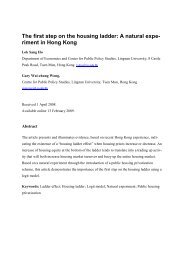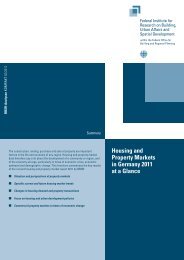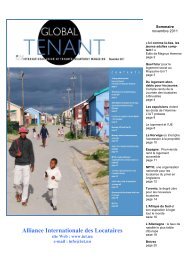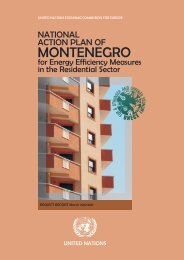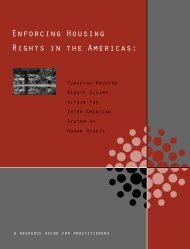housing developments in european countries - Department of ...
housing developments in european countries - Department of ...
housing developments in european countries - Department of ...
You also want an ePaper? Increase the reach of your titles
YUMPU automatically turns print PDFs into web optimized ePapers that Google loves.
Section 2<br />
Context<br />
Context Section 2<br />
2.17 Lithuania<br />
Table<br />
2.17.1<br />
Characteristics <strong>of</strong> the Hous<strong>in</strong>g Stock<br />
<strong>in</strong> Lithuania, 2002<br />
Table<br />
2.17.2<br />
Economic Trends <strong>in</strong> Lithuania, 1996-2002<br />
2.17.1 Policy Mak<strong>in</strong>g and<br />
Implementation<br />
In 1992 the government <strong>of</strong> Lithuania approved a new<br />
<strong>hous<strong>in</strong>g</strong> programme entitled Dwell<strong>in</strong>g. The key<br />
strategic objectives <strong>of</strong> this programme are as follows:<br />
■ to encourage private <strong>in</strong>itiative, <strong>in</strong>clud<strong>in</strong>g jo<strong>in</strong>t<br />
public/private <strong>in</strong>itiative, <strong>in</strong> the fields <strong>of</strong> <strong>hous<strong>in</strong>g</strong><br />
construction and apartment supervision;<br />
■ to develop the <strong>hous<strong>in</strong>g</strong> market and create<br />
conditions for freedom <strong>of</strong> choice while ma<strong>in</strong>ta<strong>in</strong><strong>in</strong>g<br />
a socially <strong>in</strong>dispensable level <strong>of</strong> non-commercial<br />
<strong>hous<strong>in</strong>g</strong>;<br />
■ to support rational (<strong>in</strong> the sense <strong>of</strong> energy and<br />
functionality) dwell<strong>in</strong>g design, while prioritis<strong>in</strong>g the<br />
family dwell<strong>in</strong>g and its appropriate environment,<br />
and<br />
■ to encourage the <strong>in</strong>sulation and physical renewal <strong>of</strong><br />
the exist<strong>in</strong>g <strong>hous<strong>in</strong>g</strong> stock.<br />
S<strong>in</strong>ce 1992 central government has <strong>in</strong>troduced <strong>hous<strong>in</strong>g</strong><br />
<strong>in</strong>itiatives <strong>in</strong> the follow<strong>in</strong>g areas: the development <strong>of</strong><br />
the mortgage market and the privatisation <strong>of</strong> State<br />
banks; the abolition <strong>of</strong> regulation <strong>of</strong> the <strong>hous<strong>in</strong>g</strong><br />
market; the transfer <strong>of</strong> formerly rented properties <strong>in</strong>to<br />
home ownership; the ma<strong>in</strong>tenance <strong>of</strong> social <strong>hous<strong>in</strong>g</strong>;<br />
<strong>hous<strong>in</strong>g</strong> subsidies for low-<strong>in</strong>come people; private<br />
property rights; renovation and modernisation <strong>of</strong><br />
multi-family houses <strong>in</strong> order to reduce energy costs.<br />
The M<strong>in</strong>istry <strong>of</strong> Environment holds responsibility for<br />
<strong>hous<strong>in</strong>g</strong> policy <strong>in</strong> Lithuania.<br />
2.17.2 Stock<br />
At the end <strong>of</strong> 2002, the size <strong>of</strong> the Lithuanian <strong>hous<strong>in</strong>g</strong><br />
stock totalled 1,291,700 dwell<strong>in</strong>gs. The number <strong>of</strong><br />
households stood at 1,356,826 <strong>in</strong> the same year, and<br />
consequently the number <strong>of</strong> dwell<strong>in</strong>gs per 1,000<br />
population <strong>in</strong> Lithuania is relatively low <strong>in</strong> European<br />
terms – 367 per 1,000 population. It is estimated that<br />
Category %<br />
Dwell<strong>in</strong>gs by period<br />
<strong>of</strong> construction < 1945 27<br />
1945-1960 19<br />
1960-1970 15<br />
1970-1980 17<br />
1980-1990 15<br />
>1990 7<br />
Dwell<strong>in</strong>gs by number<br />
<strong>of</strong> rooms per dwell<strong>in</strong>g 1 17<br />
2 37<br />
3 30<br />
4 10<br />
5+ 6<br />
Dwell<strong>in</strong>gs by availability <strong>of</strong> utilities<br />
Piped water 78.9<br />
Sewerage 76.3<br />
Central heat<strong>in</strong>g 72.0<br />
Hot water 67.4<br />
Bath<strong>in</strong>g facilities 71.8<br />
Gas 79.3<br />
the current <strong>hous<strong>in</strong>g</strong> stock <strong>in</strong> Lithuania is around 5%<br />
below that required by the population. As a result <strong>of</strong><br />
migration from rural to urban areas this shortage is<br />
most acute <strong>in</strong> the larger cities, especially <strong>in</strong> Vilnius and<br />
Klaipeda regions. In 2001, 87.2% <strong>of</strong> this <strong>hous<strong>in</strong>g</strong><br />
stock was owner-occupied, 8% was private rented, 3%<br />
was social rented and 1.8% was provided by other<br />
sources.<br />
TABLE 2.17.1 reveals that the Lithuanian <strong>hous<strong>in</strong>g</strong> stock<br />
is relatively old compared to many other <strong>countries</strong><br />
exam<strong>in</strong>ed <strong>in</strong> this review – only 7% <strong>of</strong> dwell<strong>in</strong>gs were<br />
built s<strong>in</strong>ce 1990. In addition, dwell<strong>in</strong>gs are not<br />
typically generous <strong>in</strong> proportion. Relatively few<br />
dwell<strong>in</strong>gs conta<strong>in</strong> 4 or more rooms – only 16% <strong>of</strong> the<br />
<strong>hous<strong>in</strong>g</strong> stock fell <strong>in</strong>to this category <strong>in</strong> 2002. The vast<br />
majority <strong>of</strong> dwell<strong>in</strong>gs <strong>in</strong> the country have access to<br />
piped water, sewerage, central heat<strong>in</strong>g and bath<strong>in</strong>g<br />
facilities, although the availability <strong>of</strong> these amenities is<br />
below the average for the 28 <strong>countries</strong> that are the<br />
focus <strong>of</strong> this review. These services are generally less<br />
commonly available <strong>in</strong> rural areas. In 2002, 91.9% <strong>of</strong><br />
dwell<strong>in</strong>gs <strong>in</strong> urban areas were fitted with piped water,<br />
as compared with only 50.6% <strong>of</strong> rural dwell<strong>in</strong>gs;<br />
Category 1996 1997 1998 1999 2000 2001 2002<br />
% % % % % % %<br />
Change <strong>in</strong> GDP 4.7 7.0 7.3 –1.8 4.0 6.5 6.8<br />
Annual <strong>in</strong>flation (December to December) 13.1 8.4 2.4 0.3 1.4 2.0 –1.0<br />
Unemployment rate – as measured by the labour force survey Nav Nav Nav Nav 16.4 17.4 13.8<br />
90.7% <strong>of</strong> urban dwell<strong>in</strong>gs were fitted to a sewage<br />
system, as compared to 45.1% <strong>of</strong> rural dwell<strong>in</strong>gs;<br />
83.8% <strong>of</strong> urban dwell<strong>in</strong>gs had hot water as compared<br />
to 31.8% <strong>of</strong> rural dwell<strong>in</strong>gs; while 87% <strong>of</strong> urban<br />
dwell<strong>in</strong>gs had bath<strong>in</strong>g facilities as compared to 38.9%<br />
<strong>of</strong> rural dwell<strong>in</strong>gs.<br />
2.17.3 Economy<br />
Table<br />
2.17.3<br />
TABLE 2.17.2 provides details <strong>of</strong> the key economic<br />
trends <strong>in</strong> Lithuania <strong>in</strong> recent years. It reveals that the<br />
annual rate <strong>of</strong> <strong>in</strong>crease <strong>in</strong> GDP <strong>in</strong> the country has<br />
<strong>in</strong>creased significantly <strong>in</strong> recent years from –1.8% <strong>in</strong><br />
1999 to 6.8% <strong>in</strong> 2002. Inflation has also fallen rapidly,<br />
from 13.1% <strong>in</strong> 1993 to –1.0% <strong>in</strong> 2001.<br />
Although the rate <strong>of</strong> unemployment fell between 2001<br />
and 2002, it rema<strong>in</strong>s high <strong>in</strong> comparison with most<br />
other European <strong>countries</strong>. Data from the labour force<br />
survey <strong>in</strong>dicate that <strong>in</strong> 2002, the Lithuanian<br />
unemployment rate was 13.8%. The unemployment<br />
rate among younger people is even higher than this. In<br />
2002, 41.8 <strong>of</strong> Lithuanian men aged between 15 and 19<br />
years were unemployed, as were 38.4% <strong>of</strong> their female<br />
counterparts.<br />
Demographic Trends <strong>in</strong> Lithuania, 1992-2000<br />
2.17.4 Demography<br />
In January 2003 the population <strong>of</strong> Lithuania stood at<br />
3,462,553 persons and the average household size was<br />
2.55 persons. At the end <strong>of</strong> 2002, the number <strong>of</strong><br />
households stood at 1,356, 826.<br />
The population <strong>of</strong> Lithuania has decreased <strong>in</strong> recent<br />
years. In 1992, 2,643,000 people lived <strong>in</strong> the country.<br />
TABLE 2.17.3 reveals that this decl<strong>in</strong><strong>in</strong>g population is<br />
due to both a fall<strong>in</strong>g birth rate – deaths have exceeded<br />
births <strong>in</strong> Lithuania s<strong>in</strong>ce 1994 – and negative net<br />
migration.<br />
Throughout the last decade the number <strong>of</strong> emigrants<br />
exceeded immigrants by over 6% on average.<br />
These demographic trends have also impacted on the<br />
age structure <strong>of</strong> the population. As TABLE 2.17.3<br />
demonstrates, the proportion <strong>of</strong> the population aged<br />
65 years and over has <strong>in</strong>creased, while the proportion<br />
aged under 25 years has fallen.<br />
Category 1992 1994 1996 1998 2000<br />
% % % % %<br />
Population by age group (%) 0-14 years 22.5 22.2 21.6 20.8 19.8<br />
15-24 years 13.6 13.5 13.4 13.5 14.3<br />
25-49 years 34.8 34.8 35.4 36.2 36.7<br />
50-64 years 16.7 16.8 16.4 16.1 15.9<br />
65-79 years 8.3 8.8 9.4 10.1 10.9<br />
> 80 years 2.7 2.7 2.7 2.6 2.5<br />
Population change (per 1,000 population) Net migration -6.6 -6.6 -6.5 -6.2 -5.8<br />
Natural population change 3.3 -1.1 -1.1 -1.1 -1.4<br />
56 European Union Report<br />
Regular National Report on Hous<strong>in</strong>g Developments <strong>in</strong> European Countries<br />
57





